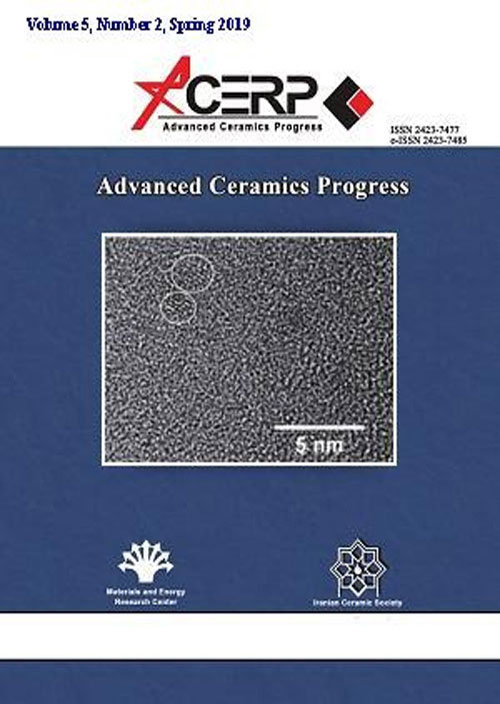فهرست مطالب

Advanced Ceramics Progress
Volume:7 Issue: 1, Winter 2021
- تاریخ انتشار: 1400/04/19
- تعداد عناوین: 5
-
-
Pages 1-10The present study investigates the structural, magnetic, and electrical properties of non-stoichiometric LaMn1-xCuxO3 (x= 0, 0.025, 0.05, 0.075, and 0.125) ceramics. The results of X-ray diffraction refinement indicated that all samples were crystallized in an orthorhombic structure and no apparent crystal structure change was introduced by doping Cu up to x=0.125. The Ferromagnetic (FM) nature revealed by non-stoichiometric LaMn1-xCuxO3-d was verified through the appearance of Paramagnetic-Ferromagnetic (PM-FM) transition temperatures in AC magnetic susceptibility measurement of the samples. Due to the coexistence of Antiferromagnetic (AFM) and FM phases, all samples contained Re-entrant Spin Glass (RSG) and Cluster Spin Glass (CSG) states. The results showed that FM phase was comparable or even dominant in the doped samples up to x=0.075; however, after doping, AFM phase overcame the FM phase as a result of reduction of double exchange interaction. Temperature dependence of resistivity measurement indicated that upon increasing the Cu-doping level, resistivity decreased, except for the x=0.125 sample, and that metal-insulator transition at low temperatures was detected in the doped samples. Furthermore, changing the magnetic phase in the case of x=0.125 sample from FM (in x=0.075) to AFM dominant phase was accompanied by changing the transport parameters obtained from small polaron hopping models.Keywords: Manganite oxides, Doping, Spin glass, Small polaron hopping
-
Pages 11-17Recently, Metal Organic Frameworks (MOFs) have been widely applied due to their high energy storage capacitance, customizable pore sizes, and open metal sites; however, their application in the form of electrode materials has been restricted due to their poor electrical conductivity. The present study reports the fast synthesis of MIL-53(Fe) and Pd/MIL-53(Fe) using the solvothermal method. To assess the electrochemical potential of materials and better understand the role of palladium in the presence of MOF, the electrodes of materials were constructed and electrochemical performances of both samples were investigated based on cyclic voltammetry in 6 M KOH electrolyte. Due to the existence of Pd in redox reaction and larger surface area, the Pd/MIL-53(Fe) showed greater electrochemical efficiency and higher specific capacitance than MIL-53(Fe). The obtained results also indicated that designing MOF via decoration of noble metal nanoparticle (MOF/noble metal) would find potential applications in the field of supercapacitors and catalysis.Keywords: Decoration, Metal organic framework, Capacitance, Electrochemistry, Nanoparticle
-
Pages 18-24An improved Fluoride Ion Cleaning (FIC) process required for removing all oxide layers by a molten mixture of alkaline fluoride salts under sub-atmospheric pressure was developed and applied to oxide layers on the cracks formed on the surface of Inconel 738-LC samples. This method is directly characterized by filling up the cracks with a molten mixture of alkaline fluoride salts (LiF-NaF-KF) overheated under sub-atmospheric pressure and subsequently, by injecting hot hydrogen gas into the process chamber. The effect of cleaning time on the microstructure of the finished surface was studied in time durations up to 120 min in intervals of 30 min using cross-sectional micrographs and elemental distribution maps. In accordance with the amount of mass loss and microstructural studies during the cleaning process, the optimum cleaning time was suggested to be 90-120 min. Perquisite microstructural outcome shows that in the suggested cleaning condition, all oxide scales in the cracks would be removed without any extra damage to the gamma prime depleted layer, which is a necessary layer for preventing sample oxidation before repair. In this regard, subsequent brazing operations need an oxide-free surface.Keywords: Alkaline fluoride salts, Cleaning, Micrograph, Oxide films, Superalloy, cracks
-
Pages 25-34In the present study, AZ31 magnesium alloy was bonded to 7075 aluminum alloy at different temperatures (393, 402, 412, and 421 °C) and diffrent holding times (25, 60, and 120 min) through diffusion bonding. Moreover, axial loads of 12, 29, 38, and 80 MPa accompanied by vacuum condition were employed during the bonding. The experimental and numerical results of the successful joints confirmed the existence of different reactive layers in diffusion zones and formation of the predicted intermetallic compounds. Findings showed that by applying a pressure of 29 MPa at different temperatures of 402, 412, and 421 °C, Interfacial Transition Zone (ITZ) with thicknesses of 21.26, 21.96, and 22.60 μm, respectively, was formed. Further, the maximum amount of the bond strength (30 MPa), resulting from the proper coalescence of metal surfaces, was obtained at 402 °C. Although the hardness of ITZ was found to be greater than that of the base metals, it could increase even more mainly as a result of an increase in the bonding temperature. Moreover, the results of simulation, using DEFORM-3D software, indicated that the ITZ had different mechanical properties from base metals and that by analyzing the effective stress, the Mg alloy specimen was more deformed than Al alloy during the joining process.Keywords: Diffusion welding, Aluminum Alloy, Magnesium alloy, Microstructure, FEM, effective stress
-
Microhardness Optimization of Al–TiC Nanocomposite Produced by Mechanical Milling and Heat TreatmentPages 35-45In this study, the Al–TiC nanocomposite was produced by the mechanical milling and sintering process. Also, the optimization of the milling parameters was performed by the Taguchi method. The X-ray diffraction analysis, scanning electron microscopy, and microhardness test were used to analyze the phase characterization, microstructure, and mechanical properties of the Al–4% TiC nanocomposite. At first, the milling speed, milling time, and ball to powder weight ratio were considered as the input data, and the microhardness was considered as the output value of the Minitab software. According to the design of the experiment, 27 experiments must be performed, which were reduced to 9 by the Taguchi method. After the milling, the powders were subjected to the cold pressing and subsequent sintering at 450 °C. The microhardness results showed that the Al–4% TiC nanocomposite was formed with a maximum microhardness of 271 HV. Furthermore, a proper model was proposed and the results indicated that there was a good agreement between the experimental and predicted microhardness.Keywords: Al–4%TiC, X-ray diffraction, Milling parameters, Taguchi method

